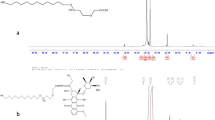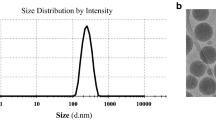Abstract
Doxorubicin (DOX), a common cancer chemotherapeutics, was conjugated to folate-modified thiolated-polyethylene glycol-functionalized gold nanoparticles. The in vitro, controlled release behavior of DOX-loaded gold nanoparticles was observed using porous dialysis membranes (cut-off = 2 kDa). DOX-loaded gold nanoparticles had higher cytotoxicity for folate-receptor-positive cells (KB cells) compared to folate-receptor-negative cells (A549 cells) which were 48 and 62% viable for 10 μM doxorubicin, respectively. This indicates the potential of these nano-carriers for targeted-delivery. In addition, healthy cell viability was 69% for 10 μM free doxorubicin whereas for the same content of drug in DOX-loaded nanoparticles healthy cell viability increased to 80%.





Similar content being viewed by others
References
Dixit V, Van den Bossche J, Sherman DM et al (2006) Synthesis and grafting of thioctic acid-PEG-folate conjugates onto Au nanoparticles for selective targeting of folate receptor-positive tumor cells. Bioconjug Chem 17:603–609
Hering K, Cialla D, Ackermann K et al (2008) SERS: a versatile tool in chemical and biochemical diagnostics. Anal Bioanal Chem 390:113–124
Hunter RJ (2001) Foundations of colloid science. Oxford University Press, New York
Kasthuri J, Veerapandian S, Rajendiran N (2009) Biological synthesis of silver and gold nanoparticles using apiin as reducing agent. Colloids Surf B Biointerfaces 68:55–60
Lee GY, Park K, Kim SY et al (2007) MMPs-specific PEGylated peptide-DOX conjugate micelles that can contain free doxorubicin. Eur J Pharm Biopharm 67:646–654
Lu W, Sun Q, Wan J et al (2006) Cationic albumin-conjugated pegylated nanoparticles allow gene delivery into brain tumors via intravenous administration. Cancer Res 66:11878–11887
Mosmann T (1983) Rapid colorimetric assay for cellular growth and survival: application to proliferation and cytotoxicity assays. J Immunol Methods 65:55–63
Patra CR, Bhattacharya R, Mukhopadhyay D et al (2008) Application of gold nanoparticles for targeted therapy in cancer. J Biomed Nanotechnol 4:99–132
Rozenberg M, Shoham G (2007) FTIR spectra of solid poly-l-lysine in the stretching NH mode range. Biophys Chem 125:166–171
Weitman SD, Lark RH, Coney LR et al (1992) Distribution of the folate receptor, GP38, in normal and malignant cell lines and tissues. Cancer Res 52:3396–3401
Xu ZP, Zeng QH, Lu GQ et al (2006) Inorganic nanoparticles as carriers for efficient cellular delivery. Chem Eng Sci 61:1027–1040
Yoo HS, Park TG (2004) Folate-receptor-targeted delivery of doxorubicin nano-aggregates stabilized by doxorubicin-PEG-folate conjugate. J Control Release 100:247–256
Zhang Z, Huey Lee S, Feng SS (2007) Folate-decorated poly(lactide-co-glycolide)-vitamin E TPGS nanoparticles for targeted drug delivery. Biomaterials 28:1889–1899
Zhang J, Rana S, Srivastava RS et al (2008) On the chemical synthesis and drug delivery response of folate receptor-activated, polyethylene glycol-functionalized magnetite nanoparticles. Acta Biomater 4:40–48
Acknowledgment
This project was supported by Biochemical and Bioenvironmental Centre of Sharif University of Technology, and also we wish to thank Sharif Institute of Nanoscience and Nanotechnology, Biotechnology Research Centre and Cell Bank Centre of Pasteur Institute of Iran, for their helpful contributions.
Author information
Authors and Affiliations
Corresponding author
Electronic supplementary material
Below is the link to the electronic supplementary material. Supplementary Fig. 1 Transmission electron microscopy (TEM) image for PEG-functionalized gold nanoparticles (PEG-SH-GdNPS) which shows the average size of the 12 nm for nanoparticles.
Rights and permissions
About this article
Cite this article
Asadishad, B., Vossoughi, M. & Alamzadeh, I. In vitro release behavior and cytotoxicity of doxorubicin-loaded gold nanoparticles in cancerous cells. Biotechnol Lett 32, 649–654 (2010). https://doi.org/10.1007/s10529-010-0208-x
Received:
Revised:
Accepted:
Published:
Issue Date:
DOI: https://doi.org/10.1007/s10529-010-0208-x




